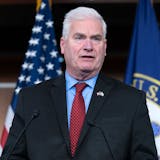HIBBING, Minn. — Nine-hundred seventy students graduated from Minnesota North College last month, little aware of how their experience over the past year holds lessons for the entire state.
If you haven't heard of Minnesota North, that's OK. It formed just last year in the merger of five community colleges across six northern Minnesota towns spanning an area the size of Maryland.
On the surface, the merger is a recognition of the cold reality I wrote about last week: the effects of declining population and leveling economic growth of Minnesota beyond the Twin Cities are turning more severe. Enrollment at the combined schools of Minnesota North fell 30% over the last 10 years.
"How do you turn that around?" Michael Raich, president of Minnesota North, asked. "There's two major ways. Number one is you find a new audience. And the second way is to do a better job with retaining and helping the people at the college to be successful."
But there's more to the Minnesota North story. As I've also written about from my first column onward, the leveling-off of growth represents opportunity as well as challenge for Minnesotans.
And the leaders of Minnesota North show what I mean. They did much more than look for ways to cut costs.
Since making the decision to merge in 2019, they've taken a fundamentally different approach to the role that a community college plays with students and employers. Teachers and staff became more deeply involved in students' lives, worked more directly with employers and recruited more people on the fringes of the workforce.
"What you see in Minnesota North is 'All right, here we are. Are we going to make this work or are we going to give up?'" said Tuleah Palmer, chief executive of the Blandin Foundation, the Grand Rapids-based philanthropy that's an occasional benefactor to the schools that now form Minnesota North. "They went through this grip-the-guts moment and said 'Let's make this work.'"

